You are using an out of date browser. It may not display this or other websites correctly.
You should upgrade or use an alternative browser.
You should upgrade or use an alternative browser.
Bajuni (with a Somali mother) DNA results
- Thread starter Al-Ma'mun
- Start date
The dude is an Arab. E-m123 are the real Arabs. Our haplogroup, E-m78, was found in Ain Al Ghazal site but it was never found among the Nautfians. The Nautfians were exclusively E-M123 like our friend here. I am eager to know more about his paternal matches to know the specific place his ancestor came from because that will give us an insight who we were trading with.
Natufians are like 10k years old while the Arab ethnic group (Arabic speaking pastoralists in the Levant) as we know it are only 2800 years old if we are going by the earliest Arabic inscription. E-M123 is widespread all over Western Eurasia, this lineage might have came to Africa via an Iranian,Yemeni,Balochi,Egyptian,Omani who knows lol.
But yes generally it seems the original Pre-Proto-Semites in the Sinai were likely E-M123 heavy and then later absorbed the Neolithic lineages of the Levant probably related to those Anatolian Farmers.Later on with the arrival of Iranian Neolithic Farmer ancestry J1 arrived and was very successful among the Peninsular Arabians due to founder effects (majority of Arabia was Arabized and spoke different Semitic tongues).
But yes generally it seems the original Pre-Proto-Semites in the Sinai were likely E-M123 heavy and then later absorbed the Neolithic lineages of the Levant probably related to those Anatolian Farmers.Later on with the arrival of Iranian Neolithic Farmer ancestry J1 arrived and was very successful among the Peninsular Arabians due to founder effects (majority of Arabia was Arabized and spoke different Semitic tongues).
Apollo
VIP
@Al-Ma'mun
Have you ever seen results from Kenyan Bajunis? I think they may have some proto-Somaloid admixture as their land used to be inhabited by the Booni who (before mixing with Swahilis) were a mixture of Somalis (Garre type) and hunter-gatherers.
Have you ever seen results from Kenyan Bajunis? I think they may have some proto-Somaloid admixture as their land used to be inhabited by the Booni who (before mixing with Swahilis) were a mixture of Somalis (Garre type) and hunter-gatherers.
I haven't seen full blown Bajuni results tbh but I know they were included in some study maybe @Shimbiris remembers.@Al-Ma'mun
Have you ever seen results from Kenyan Bajunis? I think they may have some proto-Somaloid admixture as their land used to be inhabited by the Booni who (before mixing with Swahilis) were a mixture of Somalis (Garre type) and hunter-gatherers.
The Bajuni parent of this individual probably carries significant Cushitic ancestry but it's probably less than 25%. And I agree with you that it must be some indigenous Cushitic Somaloid ancestry as ethnic Somalis are quite recent additions to the region.
Last edited:
60.8% not bantu and 54% Somali? I'm pretty sure Bajunis are related to somalis.
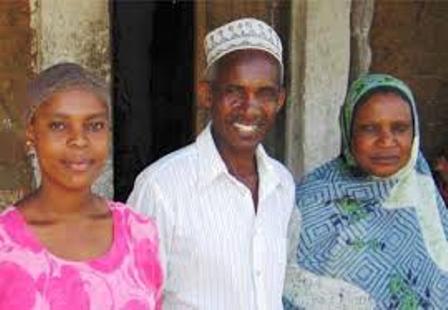

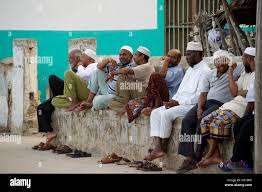

I haven't seen full blown Bajuni results tbh but I know they were included in some study maybe @Shimbiris remembers.
The Bajuni parent of this individual probably carries significant Cushitic ancestry but it's probably less than 25%. And I agree with you that it must be some indigenous Cushitic Somaloid ancestry as ethnic Somalis are quite recent additions to the region.
I don't remember the study. I'll do some digging sometime when I get the chance. But if I recall correctly, the traditional Bajuni narratives (their oral traditions) generally recounted that groups like Garres and Tunnis predated them in their areas of Koonfur. This also jibes with the linguistics:
If Bajunis as a whole have Somali looking ancestry it's possible it's from Maxaa Tirri speakers but it's more likely from Tunni-Garre types.
Koonfur is the "Yemen" of Somaliweyn if you really think about it. More fertile, somewhat more civilizationally prosperous region with a greater amount of linguistic diversity compared to its north. Af-Maxaa types along the northern parts of Koonfur (Ajuuraan/Hawiyes) then anything from Maay, Tunni, Jiddu, Boon, Garre... similar to how Yemen used to house Old Arabic to its north but also had Himyaritic, the Old South Arabian languages, the Modern South Arabian languages, Proto-Ethiosemitic and so on.
Last edited:
great comparison between Koonfur and YemenI don't remember the study. I'll do some digging sometime when I get the chance. But if I recall correctly, the traditional Bajuni narratives (their oral traditions) generally recounted that groups like Garres and Tunnis predated them in their areas of Koonfur. This also jibes with the linguistics:
If Bajunis as a whole have Somali looking ancestry it's possible it's from Maxaa Tirri speakers but it's more likely from Tunni-Garre types.
Koonfur is the "Yemen" of Somaliweyn if you really think about it. More fertile, somewhat more civilizationally prosperous region with a greater amount of linguistic diversity compared to its north. Af-Maxaa types along the northern parts of Koonfur (Ajuuraan/Hawiyes) then anything from Maay, Tunni, Jiddu, Boon, Garre... similar to how Yemen used to house Old Arabic to its north but also had Himyaritic, the Old South Arabian languages, the Modern South Arabian languages, Proto-Ethiosemitic and so on.
World
VIP
The Ogaden only entered the area 150 years ago max.The Bajuni, by their own admission/oral history, have entire Somali clans mixed up with them over centuries e.g. Gaaljecel and Ogaadeen.
This individual is half Somali tho.He has a Somali mother and Bajuni father60.8% not bantu and 54% Somali? I'm pretty sure Bajunis are related to somalis.
View attachment 217723

Impossible. You can't populate from Garrisa to Kismayo to the Sawahili coast all the way back to Jigijiga in less than two centuries. The only possibility for that happening is if it happened via empirical conquest and if that was the case, the wouldn't be dumb Enough to emphasize s conquering less fertile Garrisa instead of Lamu and the Sawhili coast.The Ogaden only entered the area 150 years ago max.
World
VIP
The entire Jubba-Tana territory was conquered by the Ogaden in less than 50 years. From Baardheere to the slopes of Mount Kenya. Ogaden had no presence whatsoever in Jubbaland let alone Kenya in 1850.Impossible. You can't populate from Garrisa to Kismayo to the Sawahili coast all the way back to Jigijiga in less than two centuries. The only possibility for that happening is if it happened via empirical conquest and if that was the case, the wouldn't be dumb Enough to emphasize s conquering less fertile Garrisa instead of Lamu and the Sawhili coast.
Last edited:
How do we know this is the result of a Bajuni with an Ethnic Somali mother?
At least provide a link or research paper so we can verify it or see what we are looking at.
I don't remember the study. I'll do some digging sometime when I get the chance. But if I recall correctly, the traditional Bajuni narratives (their oral traditions) generally recounted that groups like Garres and Tunnis predated them in their areas of Koonfur. This also jibes with the linguistics:
They don't just say Tunni or Garre groups predated them but some of them that live in the Dundas Islands even recount genealogies that go back to 26 generations which point to their have once been Garre. Besides the number of traditions that connect Garre to the area, there is also Garre camel brands marked an old trees across the Islands.
There is also old documents and portuguese refrences i have read that supports the presence of Somali groups in the adjacent area and the coast in the 17th century.
There is also linguistic evidence that supports all of this as you have shown in that study paper.
The Proto-Garre of the past were probably more similar to Raxanweyn, Tunni and other Sab descendant groups , in their cultural and linguistic makeup.
Last edited:
He posted these results himself on reddit.He's only half Somali from his mother side which means his father didn't have Somali ancestry but his Ethio & SE Africans scores is probably where his Cushitic ancestry is embedded in.To get a full picture we would probably need G25 coordinates or run him on qpadmHow do we know this is the result of a Bajuni with an Ethnic Somali mother?
At least provide a link or research paper so we can verify it or see what we are looking at.
It happened due to assimilation. Certain ogaden subclans such as cawliyahan, tolomoge certain MZ etc, assimilated many of the orma/arsi oromos who’s land they expanded into and many of them today are decendants of these conquered oromosImpossible. You can't populate from Garrisa to Kismayo to the Sawahili coast all the way back to Jigijiga in less than two centuries. The only possibility for that happening is if it happened via empirical conquest and if that was the case, the wouldn't be dumb Enough to emphasize s conquering less fertile Garrisa instead of Lamu and the Sawhili coast.
He posted these results himself on reddit.He's only half Somali from his mother side which means his father didn't have Somali ancestry but his Ethio & SE Africans scores is probably where his Cushitic ancestry is embedded in.To get a full picture we would probably need G25 coordinates or run him on qpadm
If thats true than you show us the link. Link it?
go to the 23&me subreddit and search Bajuni in the search bar.If thats true than you show us the link. Link it?
It happened due to assimilation. Certain ogaden subclans such as cawliyahan, tolomoge certain MZ etc, assimilated many of the orma/arsi oromos who’s land they expanded into and many of them today are decendants of these conquered oromos
There was very little assimilation of Orma, Boran or Arsi and you can see that by looking at the FST (measure of genetic distance between populations) between Ethiopian Somalis and Somalis from Somalia. The FST between the two populations is extremely low at 0.0008.
If the Ogaden had absorbed more Arsi, Boran and Orma in their expansion, the FST would be much higher than 0.0008 given how distant these groups are genetically to Somalis.

https://www.biorxiv.org/content/10.1101/2020.10.21.348599v2.full
Northern Somalis generally abhor assimilation. You can see this in that the Wardai Orma (now Known as Warday Cali) still exist as a stand alone clan in Jubaland and have an MP in the Somali parliament. Sheekhaal and various Dir clans (Bajamaal, Gaadsan etc..) have lived among the Ogaden for centuries without being assimilated at all.
https://anthrosource.onlinelibrary.wiley.com/doi/pdf/10.1525/aa.1961.63.1.02a00060
The demographic expansion of the Ogaden is due to fast population growth as they conquered new grazing land. More land means more livestock which means more milk & meat which mean more children survive into adulthood which means rapid population growth.
Trending
-
Oromo nationalist got a hold of all the simping you niggas were doing
- Started by Laiis
- Replies: 188
-
-

